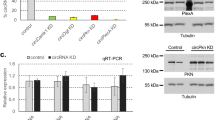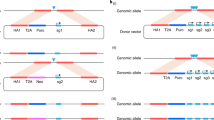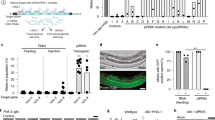Abstract
RNA-mediated interference (RNAi) is a recently discovered method to determine gene function in a number of organisms, including plants1, nematodes2, Drosophila3,4, zebrafish5, and mice6. Injection of double-stranded RNA (dsRNA) corresponding to a single gene into organisms silences expression of the specific gene2,3,4,5,6. Rapid degradation of mRNA in affected cells blocks gene expression2. Despite the promise of RNAi as a tool for functional genomics, injection of dsRNA interferes with gene expression transiently and is not stably inherited2,3,5,6. Consequently, use of RNAi to study gene function in the late stages of development has been limited. It is particularly problematic for development of disease models that reply on post-natal individuals. To circumvent this problem in Drosophila, we have developed a method to express dsRNA as an extended hairpin-loop RNA. This method has recently been successful in generating RNAi in the nematode Caenorhabditis elegans7. The hairpin RNA is expressed from a transgene exhibiting dyad symmetry in a controlled temporal and spatial pattern. We report that the stably inherited transgene confers specific interference of gene expression in embryos, and tissues that give rise to adult structures such as the wings, legs, eyes, and brain. Thus, RNAi can be adapted to study late-acting gene function in Drosophila. The success of this approach in Drosophila and C. elegans suggests that a similar approach may prove useful to study gene function in higher organisms for which transgenic technology is available.
This is a preview of subscription content, access via your institution
Access options
Subscribe to this journal
Receive 12 print issues and online access
$209.00 per year
only $17.42 per issue
Buy this article
- Purchase on Springer Link
- Instant access to full article PDF
Prices may be subject to local taxes which are calculated during checkout


Similar content being viewed by others
References
Baulcombe, D.C. RNA makes RNA makes no protein. Curr. Biol. 9, R599–R601 (1999).
Montgomery, M.K., Xu, S. & Fire, A. RNA as a target of double-stranded RNA-mediated genetic interference in Caenorhabditis elegans. Proc. Natl. Acad. Sci. USA 95, 15502–15507 (1998).
Kennerdell, J.R. & Carthew, R.W. Use of dsRNA-mediated genetic interference to demonstrate that frizzled and frizzled2 act in the wingless pathway. Cell 95, 1017–1026 (1998).
Misquitta, L. & Paterson, B.M. Targeted disruption of gene function in Drosophila by RNA interference (RNA-i): a role for nautilis in embryonic somatic muscle formation. Proc. Natl. Acad. Sci. USA 96, 1451–1456 (1999).
Li, Y.-X, Farrell, M.J., Liu, R., Mohanty, N. & Kirby, M.L. Double-stranded RNA injection produces null phenotypes in zebrafish. Dev. Biol. 217, 394–405 (2000).
Wianny, F. & Zernicka-Goetz, M. Specific interference with gene function by double-stranded RNA in early mouse development. Nat. Cell Biol. 21, 70–75 (2000).
Tavernarakis, N., Wang, S.L., Dorovkov, M., Ryazanov, A. & Driscoll, M. Heritable and inducible genetic interference by double-stranded RNA encoded by transgenes. Nat. Genet. 24, 180–183 (2000).
Brand, A.H. & Perrimon, N. Targeted gene expression as a means of altering cell fates and generating dominant phenotypes. Development 118, 401–415 (1993).
Spradling, A.C., & Rubin, G.M. Transposition of cloned P elements into Drosophila germ line chromosomes. Science 218, 341–347 (1982).
Martinek, S. & Young, M.W. Specific genetic interference with behavioural rhythms in Drosophila by expression of inverted repeats. Genetics, in press (2000).
RNAi In Drosophila Embryos. http://www.pitt.edu/~carthew/manual/RNAi_Protocol.html
Davison, A. & Leach, D.R. The effects of nucleotide sequence changes on DNA secondary structure formation in Escherichia coli are consistent with cruciform extrusion in vivo. Genetics 137, 361–368 (1994).
Ausubel, F.M. et al. Current protocols in molecular biology. (Greene Publishing Assoc., Inc. and John Wiley & Sons, Inc., New York, NY; 1993).
Hama, C., Ali, Z. & Kornberg, T.B. Region-specific recombination and expression are directed by portions of the Drosophila engrailed promoter. Genes Dev. 4, 1079–1093 (1990).
Wang, Z. & Grabowski, P.J. Cell- and stage-specific splicing events resolved in specialized neurons of the rat cerebellum. RNA 2, 1241–1253 (1996).
Foley, K.P., Leonard, M.W. & Engel, J.D. Quantitation of RNA using the polymerase chain reaction. Trends Genet. 9, 380–385 (1993).
Jarman, A.P., Grau, Y., Jan, L.Y. & Jan, Y.N. atonal is a proneural gene that directs chordotonal organ formation in the Drosophila peripheral nervous system. Cell 73, 1307–1321 (1993).
Vincent, J.P., Girdham, C.H., & O'Farrell, P.H. A cell-autonomous, ubiquitous marker for the analysis of Drosophilaw genetic mosaics. Dev. Biol. 164, 328–331 (1994).
Kauffmann, R.C., Li, S., Gallagher, P., Zhang, J. & Carthew, R.W. Ras1 signaling and transcriptional competence in the R7 cell of Drosophila. Genes Dev. 10, 2167–2178 (1996).
Author information
Authors and Affiliations
Corresponding author
Rights and permissions
About this article
Cite this article
Kennerdell, J., Carthew, R. Heritable gene silencing in Drosophila using double-stranded RNA. Nat Biotechnol 18, 896–898 (2000). https://doi.org/10.1038/78531
Received:
Accepted:
Issue Date:
DOI: https://doi.org/10.1038/78531
This article is cited by
-
dMyc-dependent upregulation of CD98 amino acid transporters is required for Drosophila brain tumor growth
Cellular and Molecular Life Sciences (2023)
-
Topical application of dsRNA for plant virus control: a review
Tropical Plant Pathology (2022)
-
The sugar-responsive enteroendocrine neuropeptide F regulates lipid metabolism through glucagon-like and insulin-like hormones in Drosophila melanogaster
Nature Communications (2021)
-
Production of petaloid phenotype in the reproductive organs of compound flowerheads by the co-suppression of class-C genes in hexaploid Chrysanthemum morifolium
Planta (2021)
-
A versatile toolkit for CRISPR-Cas13-based RNA manipulation in Drosophila
Genome Biology (2020)



